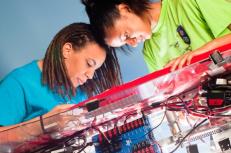Editor’s Note: Technology is at the fingertips of practically every teenager. Apps and automation find their way into every corner of teenagers' lives. We used to think the high-tech world belonged to a small sector of boys and men who liked computers and lacked social skills. That's simply no longer the case. Today, technology has filtered into nearly every field. Being able to use and understand computers is as essential as reading and writing. According to the Bureau of Labor Statistics, jobs that require computer and math skills are each projected to grow by more than 20 percent in the next decade—and that is not limited to just the traditional technology and engineering jobs.
In this new reality, all girls (and boys) must master a variety of technical skills and be encouraged to venture into the science, technology, engineering, and math fields, as well. The high-tech world also raises an important issue for girls' career development for: technological advances can either empower girls to overcome significant gender gaps, or have the opposite effect of increasing the gender gap and leaving young women behind.
Unfortunately, studies show that girls begin to lose confidence and interest and science and math during middle school. The Girl Scouts of Central Texas EDGE program offers unique programs and workshops designed to get girls excited about science, technology, engineering, and math. The Girl Scouts’ programs are increasing girls' confidence with technology and preparing them to successfully meet future workforce demands.
In this article, Girls Scouts of Central Texas STEM Program Coordinator Terry Olguin debunks myths about girls and technology.
FACT: Currently, girls are highly engaged with computers, and their usage has increased steadily over time, on par with that of boys. The percentage of students using computers at home or in school more than doubled between 1984 and 1997, with no gender differences in the rates of use in either year.1
And once girls find an opportunity to engage, their technology capacity rivals that of boys. The Girl Scouts of Central Texas has a RoboClub that exposes girls to robotics. We are one of the first to send girl teams to the First Lego League competition, where teams have to build an autonomous robot that can do as many tasks as possible in two minutes. This year we sent five teams, and four of those teams were invited to the championship round! These girls learn technical skills but also develop excellent teamwork skills.
MYTH: Boys have greater access to computers than girls.
FACT: Girls are using computers as often as boys. The amount of time girls and boys spend at the computer or on the Internet is essentially equal. 2 A vast majority of girls use Facebook (91%) and MySpace (28%) regularly. Thirty-eight percent have a Twitter account, and girls average eight tweets per day.3
MYTH: Technology achievement is more natural for men than for women.
FACT: People with liberal arts degrees, specialized training, and critical thinking skills can fill up to 80 percent of information technology jobs. Girls’ strengths in reading and writing, combined with their current use of technology for communication and social functions, provides an entrée to teach girls more technical skills.
Linda M. Sherr, program director of IBM Women in Technology, notes that “currently, much of the software designed for children is geared toward boys. Not surprisingly, many software game designers are men. We need women and girls to be part of the equation.” Research suggests that we can work toward re-visioning technology so that it incorporates and builds on the perspectives and values that girls bring to it, rather than focusing on how we can help girls adapt to the predominantly male world of technology. 4
MYTH: All of us, female and male alike, use technology similarly.
FACT: Research demonstrates the striking differences in how girls and boys use technology. In their Internet use, girls emphasize educational and communicative functions, while boys tend to use computers more for entertainment and recreational purposes. Girls use technology as a tool of empowerment, sharing, creation, and expressiveness. Boys use it in ways related to control, power, and autonomy. 5
In order for girls to gain technology competencies, we need to pay attention to how girls learn and apply technology. Girls see technology as a means to an end. Rather than having Jane sit down and figure out how Publisher works, Jane needs to learn that to make herself heard, she can use Publisher in these ways. At the Girl Scouts, we are developing a Media Team of girls that will learn photography, develop blogs, and acquire writing and publishing skills to put together our electronic newsletters and communications. They will also learn presentation skills and complete their own public service announcements. Technology must be used as a springboard to help girls communicate effectively and safely, use their voices, and ask and answer questions.
MYTH: Gender-neutral software, beneficial to the technology styles and interests of both girls and boys, is universally available and prevails in the market.
FACT: Almost half the top-selling video games with female characters contain negative messages about girls, including violence, unrealistic body images, and stereotypical female characteristics (e.g., provocative sexuality, high-pitched voices, and fainting).
We try to create ideal environments for girls to explore technology, assert themselves, and gain self-esteem. Café Click is a fun, girls-only environment at the EDGE Technology Center in the Kodosky Program Center. Our first rule is that girls must leave “I can'ts” out in the hallway and know that they have the ability to tackle complex problems and new tools.
Girls can create fliers, brochures, and spreadsheets or do research for school. They can explore Web 2.0 tools and tackle science, technology, engineering, or math (STEM) projects with style and confidence working with volunteers and staff in a safe, secure social networking group.
MYTH: Girls today have strong women role models in science and technology. They are finding their way into careers in those fields in increasing numbers.
FACT:Even girls with strong skills in math, science, and technology do not pursue careers in those areas. This may be because they do not have women to mentor them into the field, and because they find the male-defined environments stylistically unaccommodating to women. Sally Ride, the NASA astronaut explains, “the key is to identify girls' interests at an early age, provide them with the opportunities to learn about math, science, and technology, and link them together in a support network to keep them motivated.”
We have a program at Girl Scouts in which the girls are able to work on projects with female role models from the Society of Women Engineers and the University of Texas at Austin Engineering Program.
MYTH: Increased use of technology by girls has led to increased career choices and opportunities in the field of information technology.
FACT: Girls' increasing use of technology is not mirrored by adult academic or economic pursuits in these arenas. For more than twenty years, educators, policymakers, and employers have been concerned about the gender gap in the science, technology, engineering, and math (STEM) fields. A lot of attention has been applied toward getting girls into STEM in order to open these career avenues for girls. And progress is certainly being made. Nevertheless, men occupy the majority of positions in these fields.
We have learned that it's about more than just STEM careers—it's about every career, lifestyle, or future a girl wants to pursue. As technology creeps into every sector and facet of life, we need to consider more than just how to get girls to enter those fields—we need to make sure that girls have the skills, understanding, and responsibility to use technology in their lives.
Get Involved

|


















Comments
Thanks for highlighting that fact that girls may be interested in technology for different reasons than boys; namely, because they see it as a "means to an end" or a way to accomplish their goals. I'm interested in hearing more about how this understanding can drive not engaging girls in the use of technological tools, but how it should guide the way girls are taught math, science, and technical skills. I've wondered if the curriculum and instructional methods themselves may lead to declines in interest among girls as they progress through school.
How can I get my Girl Scouts into a STEM program? What steps could I take to assure my girl scouts troop has the tools to start applying their skills towards STEM activities and learning? I am very interested in helping them succeed with some guidance.GS Troop Leader Hays County